
- •Michelangelo buonarroti (1475 – 1564)
- •I. Practice the pronunciation of the following words and word-combinations and learn them.
- •II. Practice the pronunciation of the following (a) toponyms and (b) proper names:
- •Thomas gainsborough (1727 – 1788)
- •I. Practice the pronunciation of the following words and word-combinations and learn them.
- •II. Practice the pronunciation of the following (a) toponyms and (b) proper names:
- •John constable (1776 – 1837)
- •I. Practice the pronunciation of the following words and word-combinations and learn them.
- •II. Practice the pronunciation of the following (a) toponyms and (b) proper names:
- •The dutch school
- •I. Practice the pronunciation of the following words and word-combinations and learn them.
- •II. Practice the pronunciation of the following (a) toponyms and (b) proper names:
- •The french impressionists
Министерство образования Московской области
Государственное образовательное учреждение
высшего профессионального образования
Московский государственный областной университет
КОНТРОЛЬНАЯ РАБОТА
ПО АНГЛИЙСКОМУ ЯЗЫКУ
Факультет: _________________
Специальность: _________________
Выполнил: _________________
ФИО студента
Зачтено _________________
подпись преподавателя
Дата ___________________
Москва
2012
I
PRE-TASKS:
I. Practice the pronunciation of the following words and word-combinations and learn them.
preference ['pref(ə)rəns] – предпочтение
Pietà [ˌpɪe'tɑ:] – пьета, пиетá, плач Богоматери (картина или скульптура изображающая Богородицу скорбящую над телом Христа) [заимствовано из итальянского, от латинского pietas – сострадание, любовь]
the Virgin [ðə 'vз:dʒɪn] – «(Пресвятая) Дева», Богородица
knee [ni:] – колено
figure ['fɪgə] – фигура
subtle ['sʌtl] – утончённый, изящный, искусный
delicate ['delɪkɪt] – тонкий, едва уловимый
sufficient [sə'fɪʃənt] – достаточный
to commemorate (some event) [kə'meməreɪt] – отмечать, праздновать какое-л. событие; устраивать в память, ознаменовывать
start in ['stɑ:t 'ɪn] – (разг.) начинать, приступать
without a flaw [wɪ'ðaʊt ə 'flɔ:] – безупречно
feature ['fi:t∫ә] – черта (лица); характерная черта
an acre ['eɪkə] – акр
(мера площади в Великобритании и США = 4,046.86 м²)
niche [ni:∫] – ниша
II. Practice the pronunciation of the following (a) toponyms and (b) proper names:
(a) Bologna [bə'ləʊnjə] – г. Болонья
Vatican ['vætɪkən] – (государство-город) Ватикан
Venice ['venɪs] – г. Венеция
(b) Adam ['ædəm] – Адам
David ['deɪvɪd] – Давид
Ghirlandaio [ˌgз:lən'dɑ:jəʊ] – Гирландайо
the Libyan Sybil [ðə 'lɪbɪən 'sɪb(ɪ)l] – Ливийская Сивилла
Magdalene ['mægdəlɪn] – Магдалина
Michelangelo Buonarroti [ˌmaɪkə'læŋʒɪləʊ ˌbwɒnə'rɒtɪ] –
Микеланджело Буонарроти
the Prophet Jeremiah [ðə 'prɒfɪt ˌdʒerɪ'maɪə] – пророк Иеремия
Saint John [sənt 'dʒɒn] – святой Иоанн
Saint Peter [sənt 'pi:tə] – святой Пётр
Read and translate the text.
Michelangelo buonarroti (1475 – 1564)
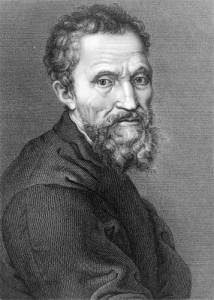 Michelangelo
Buonarroti was born in 1475 in a small town near Florence. When
Michelangelo was thirteen he was apprenticed to Ghirlandaio for three
years during which time he showed a definite preference for
sculpture.
Michelangelo
Buonarroti was born in 1475 in a small town near Florence. When
Michelangelo was thirteen he was apprenticed to Ghirlandaio for three
years during which time he showed a definite preference for
sculpture.
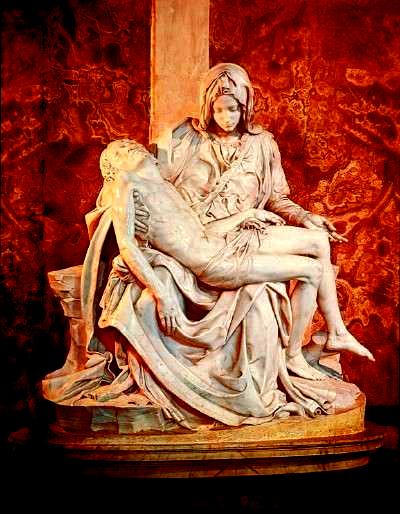 In 1494,
he visited Venice and Bologna before going on to Rome to execute his
Pietà for Saint Peter’s (1498 – 1500). The subject is a very
difficult one, for the Virgin holds the body of Christ across her
knees. Earlier Renaissance sculptors had added Saint John and
Magdalene to the scene to help support the inert body and prevent it
from seeming to crush the frail Madonna. Michelangelo excluded the
two figures and by subtle positioning and by exaggerating slightly
the scale of the Virgin he created a compact and isolated monument of
extraordinary emotional force.
In 1494,
he visited Venice and Bologna before going on to Rome to execute his
Pietà for Saint Peter’s (1498 – 1500). The subject is a very
difficult one, for the Virgin holds the body of Christ across her
knees. Earlier Renaissance sculptors had added Saint John and
Magdalene to the scene to help support the inert body and prevent it
from seeming to crush the frail Madonna. Michelangelo excluded the
two figures and by subtle positioning and by exaggerating slightly
the scale of the Virgin he created a compact and isolated monument of
extraordinary emotional force.
Within the majestic dignity of the group there appear countless delicate contrasts. The rigid lines of Christ angle across and around the graceful curves of the Madonna as she rests resignedly, her knees sloping forward, her body arching back and then forward, protectively above. This is the first work Michelangelo ever signed. Legend has it that after the group was installed in the chapel, some northern visitors were overheard attributing it to one of their own countrymen. Whatever the cause, he carved “Michael Angelus Bonarotus Florentinus Faciebat” on the broad strap that runs across the left breast and shoulder of the Virgin. Before long, however, his distinctive style would grow to be as good as a master’s signature.
On his return to Florence in 1502 Michelangelo signed a contract to make the famous statue of David which was to commemorate the deliverance of the city from her enemies. Contract in hand, he started in at once. Around the marble he built a shed which was locked at all times, a precaution that implies a preference for his own company, a distrust of his fellows, and, very possibly, a sharp sense of publicity. He worked with a furious energy so great that he often slept in his clothes, grudging the time it took to take them off and put them on again.
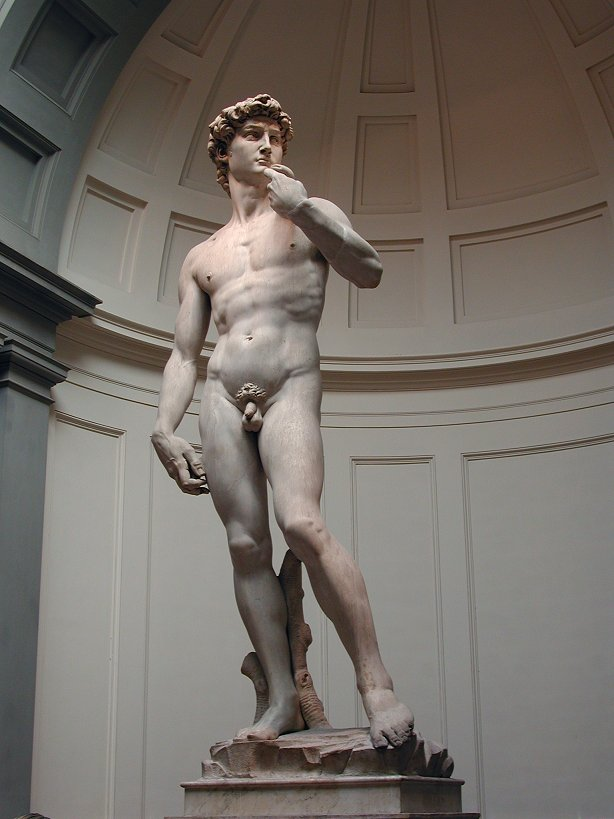
 Technically
this statue marked a change in Michelangelo’s development. In a
single work he achieved the difficult transition from normal scale to
the colossal without a flaw, setting back the chin slightly, so that
it would not cut off too much of the features from the spectator’s
view, building out the nose and forehead, placing the eyes on a
subtly slanting plane. He relied on the sharp turn of the neck to
animate the profile and selected veins and sinews to give telling
vitality to the surface.
Technically
this statue marked a change in Michelangelo’s development. In a
single work he achieved the difficult transition from normal scale to
the colossal without a flaw, setting back the chin slightly, so that
it would not cut off too much of the features from the spectator’s
view, building out the nose and forehead, placing the eyes on a
subtly slanting plane. He relied on the sharp turn of the neck to
animate the profile and selected veins and sinews to give telling
vitality to the surface.
At the
age of thirty Michelangelo was called to Rome and for the next thirty
years he worked there for a succession of Popes. Apart from the
unfinished tomb for Pope Julius II, which was to have been his
masterpiece in sculpture, the most important work of this period is
the magnificent and e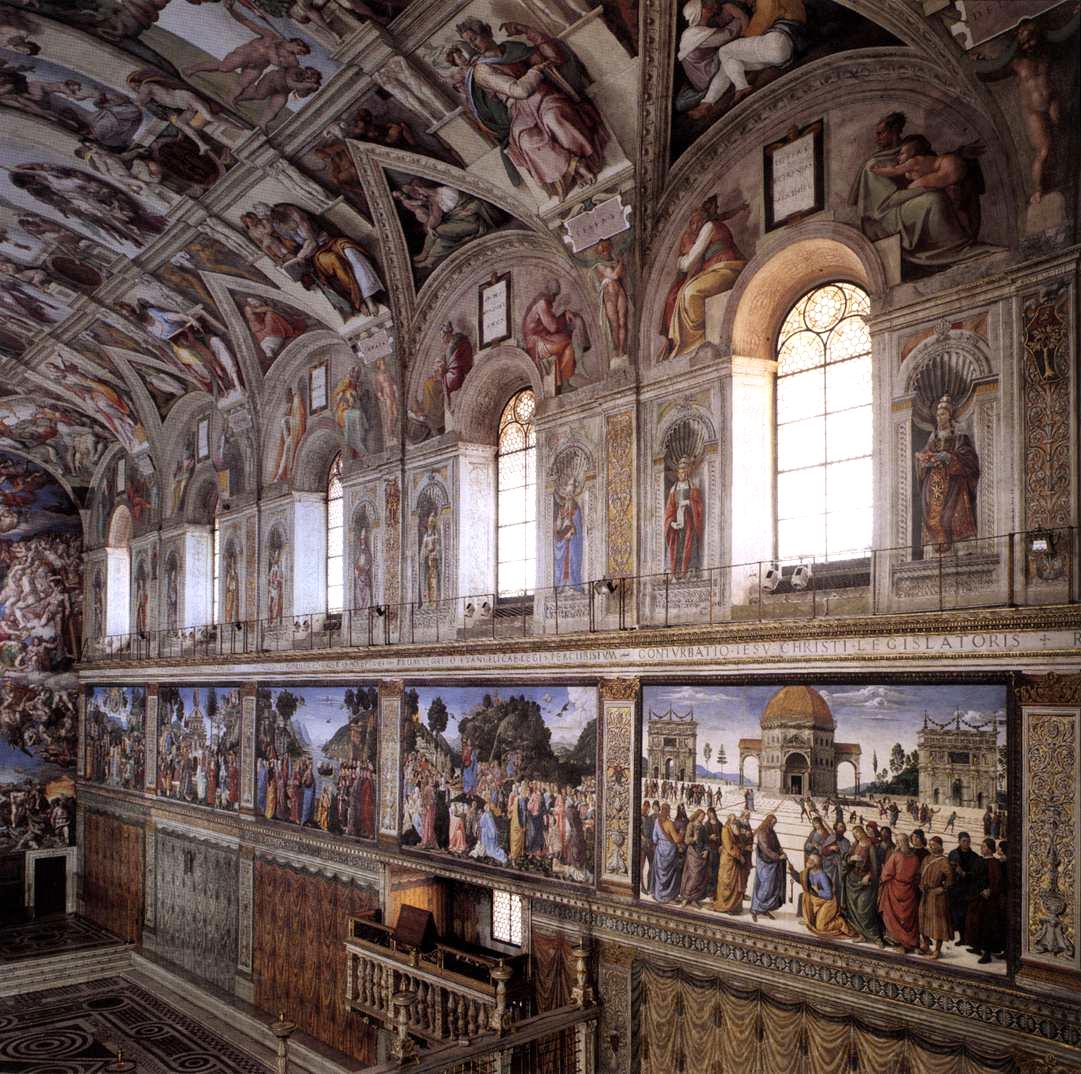 laborate
painting on the ceiling of the Sistine Chapel in the Vatican. This
immense ceiling, almost an acre in area, is forty feet above the
ground, curved in form and interrupted by window openings. It would
have been a tremendous problem to any experienced painter; as for
Michelangelo, who had as yet done very little painting, and nothing
at all on an overhead surface, it was a formidable challenge.
laborate
painting on the ceiling of the Sistine Chapel in the Vatican. This
immense ceiling, almost an acre in area, is forty feet above the
ground, curved in form and interrupted by window openings. It would
have been a tremendous problem to any experienced painter; as for
Michelangelo, who had as yet done very little painting, and nothing
at all on an overhead surface, it was a formidable challenge.

 The
Prophet Jeremiah on the Sistine ceiling is one of the most expressive
figures; the bent shoulders and general downward movement symbolize
the sadness of this great seer, who sits, chin in hand and eyes half
closed, revealing his thoughtful dejection. Most masters of the High
Renaissance were able to express the emotions of their figures
through positions of the arms and legs or postures of the body; they
attached as much importance to these factors as to the expression on
the face itself. This is as true of Jeremiah as of Adam in the
Creation scene (also on the ceiling of the Sistine Chapel) or
Leonardo’s “Madonna of the Rocks”.
The
Prophet Jeremiah on the Sistine ceiling is one of the most expressive
figures; the bent shoulders and general downward movement symbolize
the sadness of this great seer, who sits, chin in hand and eyes half
closed, revealing his thoughtful dejection. Most masters of the High
Renaissance were able to express the emotions of their figures
through positions of the arms and legs or postures of the body; they
attached as much importance to these factors as to the expression on
the face itself. This is as true of Jeremiah as of Adam in the
Creation scene (also on the ceiling of the Sistine Chapel) or
Leonardo’s “Madonna of the Rocks”.
What is especially striking and characteristic of Michelangelo in the portrayal of Jeremiah is the illusion of a three-dimensional space in which the figure can actually move. This is effected through the powerful contour line of the form itself, and the painted recess of the niche in which it is set. Jeremiah’s legs are drawn in under him, implying the same possibility of movements as do the hunched shoulders and sunken head.
When the monumental painting in the Sistine Chapel was finished, it was signed: “Michelangelo, Sculptor”.

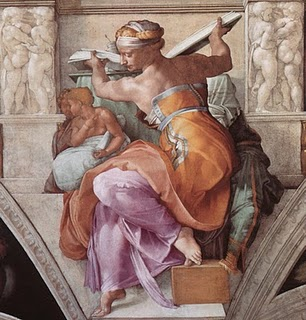 Michelangelo’s
thoughtful, passionate force of character was reflected in his work,
with its abundance of contorted nudes whose emotions are expressed
through the device of turning one part of the body in a different
direction from another, and yet balancing the parts of the body. In a
study for Sistine Chapel ceiling the Libyan Sybil is drawn in red
chalk. The chalk lines model with great force the forms of the head
and the mighty back and arms. Great care has been given to the
anatomical structure of the figure and the muscles show with more
distinctness and salience than they would even in the most highly
trained athlete. The figure has been thought of “in the round”,
from all sides, as a sculptor would conceive it, and not as an
appearance of the model from one position only – the usual practice
of painters.
Michelangelo’s
thoughtful, passionate force of character was reflected in his work,
with its abundance of contorted nudes whose emotions are expressed
through the device of turning one part of the body in a different
direction from another, and yet balancing the parts of the body. In a
study for Sistine Chapel ceiling the Libyan Sybil is drawn in red
chalk. The chalk lines model with great force the forms of the head
and the mighty back and arms. Great care has been given to the
anatomical structure of the figure and the muscles show with more
distinctness and salience than they would even in the most highly
trained athlete. The figure has been thought of “in the round”,
from all sides, as a sculptor would conceive it, and not as an
appearance of the model from one position only – the usual practice
of painters.
Illustrations: 1. Jacopino del Conte, Michelangelo, (after 1535); 2. Michelangelo, Pietà, 1498-1499, marble, 68.5 x 76.8 in. (174 x 195 cm), St. Peter’s Basilica, Vatican City, Italy; 3. Michelangelo, David (1504), carrara marble, Galleria dell'Accademia, Florence; 4. Michelangelo, Tomb of Pope Julius II, marble, San Pietro in Vincoli, Rome; 5. Michelangelo, The Prophet Jeremiah; Sistine Chapel, Vatican City; 6. Michelangelo, The Creation of Adam, Sistine Chapel, Vatican City; 7. Michelangelo, Libyan Sybil (study), 1508; 8. Michelangelo, Libyan Sybil, 1510.
TASKS:
I. Give Russian equivalents of the following.
1. to show a definite preference for smth; 2. to execute (a picture); 3. majestic dignity; 4. to rest resignedly; 5. Legend has it that … ; 6. to attribute smth to smb; 7. from this time on; 8. on smb’s return; 9. statue to commemorate (some event); 10. a preference for one’s own company; 11. a sharp sense of publicity; 12. to grudge the time it takes to do smth; 13. (a piece of art) marks a change in an artist’s development; 14. a succession of Popes; 15. the ceiling interrupted by window openings; 16. to attach importance to smth; 17. to effect an illusion through smth.; 18. to draw in one’s legs under oneself; 19. an abundance of smth; 20. through the device of (doing) smth.
II. Give English equivalents of the following:
1. отдать кого-л. в подмастерья кому-л.; 2. не дать чему-л. показаться каким-л.; 3. преувеличивать что-л.; 4. линии (какой-л. фигуры) пересекают наискосок что-л.; 5. случайно услышать как кто-л. делает что-л.; 6. соотечественник, земляк; 7. чей-л. характерный стиль; 8. избавление города от врагов; 9. подразумевать что-л., свидетельствовать, «говорить» о (чём-л.); 10. недоверие к кому-л.; 11. особое умение заинтриговать общественность; 12. безупречно; 13. загораживать черты лица от зрителей; 14. придавать особую живость (произведению искусства); 15. Сикстинская Капелла; 16. сложнейшая задача (2 варианта); 17. Это можно сказать как в отношении (кого-л.), так и в отношении (кого-л. ещё); 18. сгорбленные плечи; 19. склонённая голова; 20. уделять большое внимание чему-л.
III. Match the definitions below with the following words:
abundance; an apprentice; to attribute; to commemorate; dejection; dignity; to exaggerate; a flaw; frail; to imply; a precaution; publicity; to rely; slanting; a succession; three-dimensional.
1. activity meant to stimulate the interest of the public; 2. set at an angled position; 3. to make smth. seem more superior or inferior than it is in reality; 4. the condition of being worthy of respect, esteem or honour; 5. to claim that smth was produced by a particular person, often wrongly; 6. to honour the memory of smb or smth; 7. appearing to possess the dimentions of height, width and depth; 8. to suggest smth indirectly, as a logical consequence of smth; 9. a young person working for a skilled person for a fixed period, usually for low wages, in return for being taught his employer’s skill in art, craft or trade; 10. a mistake that prevents smth from being totally perfect and detracts from its value; 11. physically weak or delicate and vulnerable to injury; 12. to have faith or confidence in smth or smb; 13. a sequence of people or things following each other in time or order; 14. sadness and lack of hope, especially as a result of disappointment; 15. an action taken in advance to avoid danger, to prevent problems, etc.; 16. a quantity that is more than enough.
IV. Match the adjectives with the nouns the way they are used in the text.
1. emotional A. body
2. delicate B. dignity
3. inert C. curve
4. furious D. plane
5. graceful E. turn
6. slanting F. contrast
7. distinctive G. force
8. telling H. energy
9. three-dimensional I. style
10. elaborate J. ceiling
11. immense K. problem
12. sharp L. vitality
13. tremendous M. painter
14. experienced N. painting
15. formidable O. dejection
16. thoughtful P. challenge
17. majestic Q. shoulders
18. hunched R. space
II
PRE-TASKS:
